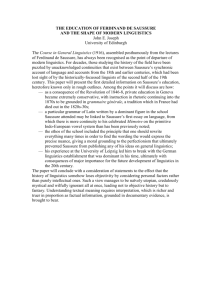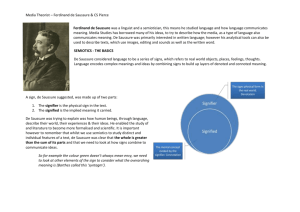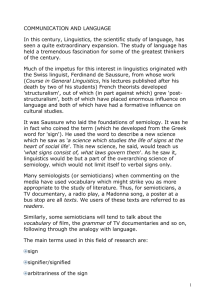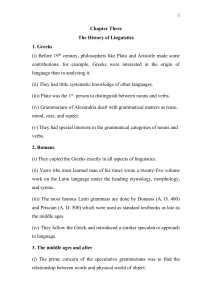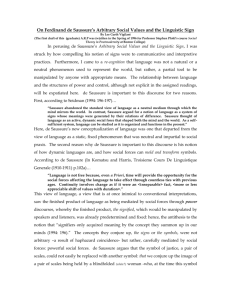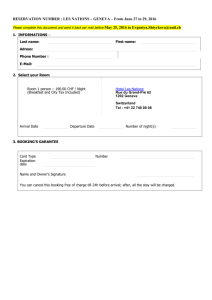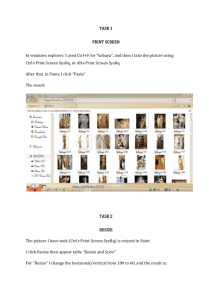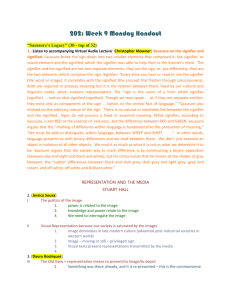The skies of Mont Blanc
advertisement
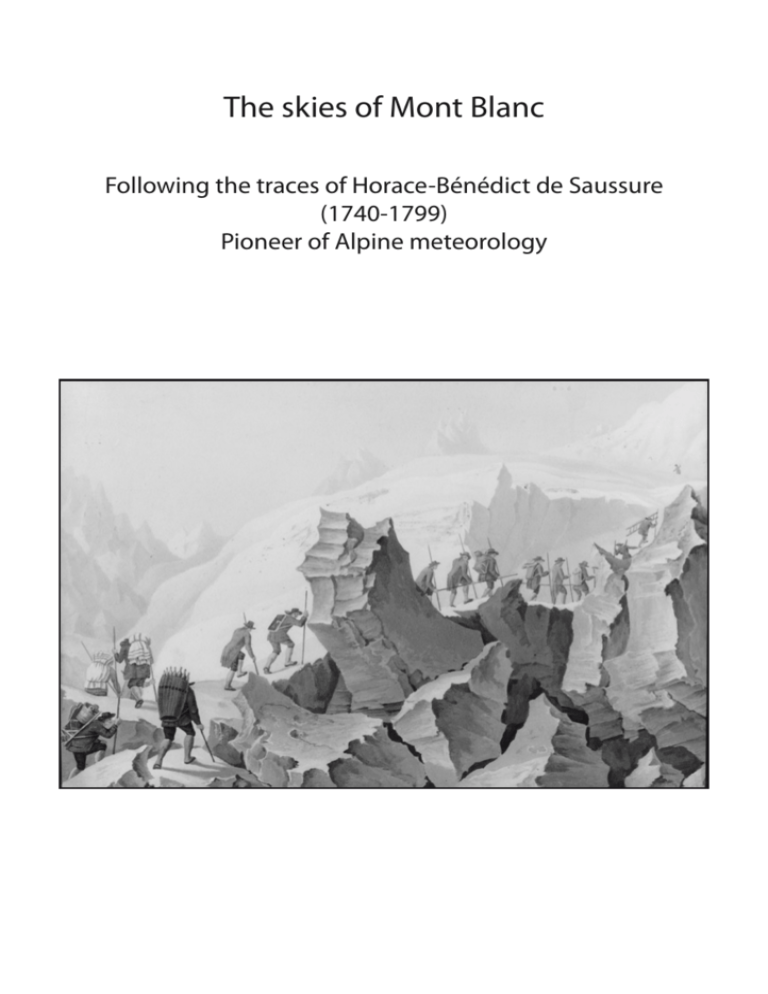
The skies of Mont Blanc Following the traces of Horace-Bénédict de Saussure (1740-1799) Pioneer of Alpine meteorology The skies of Mont Blanc “I thought that it would be interesting to work… by staying for some time on a high peak in order to follow the daily operation of various meteorological instruments, the barometer, thermometer, hygrometer, electrometer, etc., to seize opportunities to observe the origin of different weathers such as rainfall, winds and storms.” Horace-Bénédict de Saussure, “Voyage dans les Alpes”, 1796, Volume IV, Chapter 1, Séjour au Col du Géant The instruments used by Horace-Bénédict de Saussure, indefatigable explorer of Alpine summits, are displayed in the room showing the scientific development of meteorology at the Musée d’histoire des Sciences. The Geneva scholar was born in 1714 and grew up during the period when European countries were organising scientific expeditions to hitherto unknown regions. The young Horace-Bénédict turned to Mont Blanc, very close to Geneva but still unexplored. At the age of 20, he decided that he would climb to the summit and announced to the Chamonix population that there would be a prize for the first person to find a route. After many attempts, the summit was finally reached in 1786 and the following summer, after waiting for 27 years, de Saussure was at last able to achieve his ambition. Engraving : Vue de l’aiguille du Géant prise du côté de l’Ouest derrière les Tentes, illustrating “Voyages dans les Alpes”, 1796, Volume IV, Plate III. Horace-Bénédict de Saussure stayed here for 17 days with his son, Nicholas-Théodore, in the summer of 1788. A stone cabin, two tents and a pole on which to hang instruments can be seen. The four hours he spent high up on Mont Blanc in 1787 was too short to observe and measure all that he had planned, especially as he was severely weakened by “mountain sickness” because of the altitude. The next year, therefore, he installed himself with his son at the Col du Géant, about 1000 metres lower, in order to make daily meteorological observations and measurements. De Saussure’s scientific expeditions are meticulously described in the two final volumes of “Voyages dans les Alpes” published in 1796. They were a great success in Europe and ensured recognition of de Saussure as a pioneer of alpinism. Cover : “Mr de Saussure’s ascent to the summit of Mont Blanc”, published by J.P. Lamy, Berne, Basel, Lausanne and Geneva 1 Barometer Hygrometer Using mercury to measure altitude De Saussure took two barometers to Mont Blanc “for reciprocal checks”. Only the older of the two, known as the “old man”, has been preserved. It is a field instrument which gives atmospheric pressure and altitude : the higher the altitude the lighter the air thus the lower the level of mercury. By comparing the measurements he obtained at “three feet from the summit” with those made by his son NicholasThéodore in Chamonix and by his colleague Senebier in Geneva, Horace-Bénédict calculated the height of the summit as 2,450 toises which is within 30 metres of today’s official height of 4,810 metres. Photo : the barometer which de Saussure affectionately called “the old man” and which he took with him on all his mountain expeditions including to Mont Blanc and to the Col du Géant 2 Measuring humidity with strands of hair The principle underlying a hair tension hygrometer is that hair lengthens in damp air and shortens in dry air. At the summit of Mont Blanc, Horace-Bénédict de Saussaure installed two hygrometers, one in shade and the other in the sun. By comparing his measurements with those of Senebier in Geneva on the same day, he found that “at midday the air at the summit of Mont Blanc contains six times less moisture than in Geneva”. Knowing the amount of moisture in the air is still an essential measurement for meteorology. When the science was new, Horace-Bénédict de Saussure’s hair hygrometers were highly praised and demand for them came from all over Europe. As he once stated that blond hair was more reliable, it was rumoured that he used the hair of his wife Albertine. Engraving illustrating “Essais sur l’hygrométrie“ by H-B. de Saussure, 1783 De Saussure gives detailed instructions for the use of the instrument which he did not invent but which he perfected. 3 Electrometry Measuring electricity using tiny balls Electric charge in the air can be measured by the distance between two small insulating balls suspended from fine threads placed inside a glass cloche known as an electrometer. De Saussure added an aerial to increase the sensitivity of the apparatus. During the night of 4 to 5 July 1788, a fierce thunderstorm over the Col de Géant forced the scientist and his son to take refuge in a tent. Lightening struck very close and Horace-Bénédict could not resist going out to check that the balls of his electrometer were at the maximum distance one from the other thus confirming that the air was highly-charged. He was, however, very aware of the dangers of lightening. In 1771, he installed a lightening conductor on his house in Geneva shortly after having met its inventor, Benjamin Franklin, in London. De Saussure had to use all his teaching skills to reassure his terrified neighbours. Engraving illustrating “Voyages dans les Alpes”, Volume III, Plate II. Measurement of natural electricity can be done at ground level or at a height, as is shown in these illustrated instructions. 4 Cyanometer Measuring the “blueness” of the sky with squares of water colour A cyanometer shows and measures shades of blue in the sky. De Saussure made his own on small pieces of cardboard. He placed small blue squares numbered from 1 to 16 next to a space through which to observe the colour of the sky and choose the closest match. The blue squares were painted with water paints and diluted ink. The gradation of the hues had been carefully selected and tested beforehand. At the summit of Mont Blanc de Saussure measured a very dark hue between 1 and 2 on the cyanometer scale, while in Chamonix his son measured 5 to 6 and, in Geneva, Senebier’s reading was 7. At the Col du Géant a circular cyanometer was also used. This instrument had 51 hues ranging from white to black. De Saussure thought that the intensity of blue in the sky varied according to “opaque vapours” in the air. Not surprisingly, given the complexity of the subject, his investigation of the theory was not successful. He assumed, however, that the sky became black at very high altitudes. The dark colour of mountains skies did, in fact, strike fear into the inhabitants of Chamonix. Photo : the only cyanometer which has survived of the three used in 1787 5 And even more… Instruments lost or forgotten Other meteorological instruments were used by de Saussure : thermometers of course, but also a heliothermometer which has been lost. The heliothermometer, a glass box containing many thermometers, was designed to try and understand how the earth’s atmosphere was heated by the sun, in other words, our modern “greenhouse gas“ effect. De Saussure’s anemometer, an instrument to measure wind speed, was invented too late to take on his excursions. He knew that the changeable winds in the mountains would be difficult to measure so he used surveying instruments instead to observe clouds and estimate the wind speed at altitude. Finally, in July 1787, while de Saussure and his guides were waiting for good weather before climbing Mont Blanc, he meticulously prepared his diaphanometers, used for measuring the transparency of air. The diaphanometers were small black discs of different sizes on cardboard sheets. Transparency was measured according to the distance at which the discs could no longer be seen. De Saussure made it clear that none of his measures alone were enough to understand the complexity of the weather. 6 Engraving : Vue du Mont-Blanc et de la Route par laquelle on a atteint sa Cime illustrating “Voyages dans les Alpes”, 1796, Volume IV, Plate II. The route taken by Horace-Bénédict de Saussure, his servant and 18 guides and porters from Chamonix, is indicated by the dotted line. 7 De Saussure : meteorologist and geologist Mountains as laboratories for observation and measurement The Geneva scientist called mountains “nature’s laboratory”. He made the difficult climbs each summer in spite of his fragile health and the concern of his family. He carried out observations and took measurements which had never been undertaken before. He collected precise data on the atmosphere at high altitudes as we have seen, but he also gathered invaluable geological data on the formation of mountains. De Saussure was not able to finish his project to write a history of the earth, but “Voyages dans les Alpes” is enough to confirm his unique contribution to the history of European science. Further reading Carozzi Albert V., Crettaz Bernard, Ripoll David, Les plis du temps, Mythe, science et H.-B. de Saussure, Musée d’Ethnographie, Annexe de Conches, Genève, 1998, 368 p. Carozzi Albert, Horace-Bénédict de Saussure, un pionnier des sciences de la terre, Editions Slatkine, Genève, 2005, 431 p. De Saussure, H.-B. Discours préliminaire aux voyages dans les Alpes, préface d’Albert V. Carozzi, Editions Mini Zoé, Carouge (Genève), 1998, 48 p. De Saussure, H.-B., Premières ascensions au Mont-Blanc 1774-1787, Introduction de Roger Canac, Editions La Découverte/Poche, Paris 2005, réimpression de l’édition de Paris, 1979, 220 p. De Saussure, H.-B., Voyages dans les Alpes, Avant-propos par Albert Carozzi, Editions Slatkine, Genève, 2002, 300 p. Sigrist René, Le capteur solaire de Horace-Bénédict de Saussure, Editions PasséPrésent, Librairie Jullien Editeur, 1993, 224 p. Sigrist René (dir.), Horace-Bénédict de Saussure (1740-1799), Un regard sur la terre. Bibliothèque d’histoire des sciences, Georg Editeur, 2001, 541 p. Regarding “Voyages dans les Alpes” : the first editions in four volumes were published between 1779 and 1786. It is available for consultation in eight volumes in the library of the History of Science Museum. They combine a diary of the expeditions, a very fashionable approach in the 18th century, with exhaustive and rigorous lists of observations and measurements. Engraving by Charles Pradier : Horace-Bénédict de Saussure, Professeur de philosophie alpine, Membre de plusieurs Académies The scientist’s geological hammer can be seen in his hand and, on the right, his hygrometer and barometer case. 8 Concept and text : Anne Fauche and Stéphane Fischer, Musée d’histoire des sciences, Geneva Translation : Liz Hopkins Graphic design : Corinne Charvet, Natural History Museum, Geneva Printing and production : Bernard Cerroti, Muséum d’histoire naturelle © MHS September 2011 Musée d’histoire des sciences, Villa Bartholoni, Parc de la Perle du lac, rue de Lausanne 128, 1202 Genève Tél : + 41 22 418 50 60 Open each day from 10h-17h except Thuesday Email : mhs@ville-ge.ch Web : www.ville-ge.ch 9 Other guides to the permanent collection available : • Révolution(s) – A brief history of celestial measurement told through some of the astronomical instruments in the Musée d’histoire des sciences of Geneva. September 2011 • Through the looking glass : once upon a time, there was electricity - The story of electricity told through the collection of instruments of the Musée d’histoire des sciences of Geneva. September 2011 • Sun time : Description and use of the main types of sundial exhibited at the Musée d’histoire des sciences of Geneva. September 2011 • Seeing the infinitely small : Instruments at the Musée d’histoire des sciences of Geneva trace the history of microscopy. September 2011 • Observing the sky : A brief introduction to astronomy and presentation of instruments from the first Geneva Observatory. September 2011 • The Pictet Cabinet : The art of teaching science through experiment. September 2011 • From foot to metre, from marc to kilo : The history o weights and measures illustrated by objects in the collections of the Musée d’histoire des sciences of Geneva. September 2011 This booklet can be downloaded at www.ville-ge.ch/mhs D É PA R T E M E N T D E L A C U LT U R E
